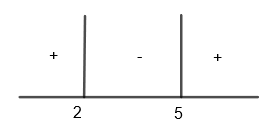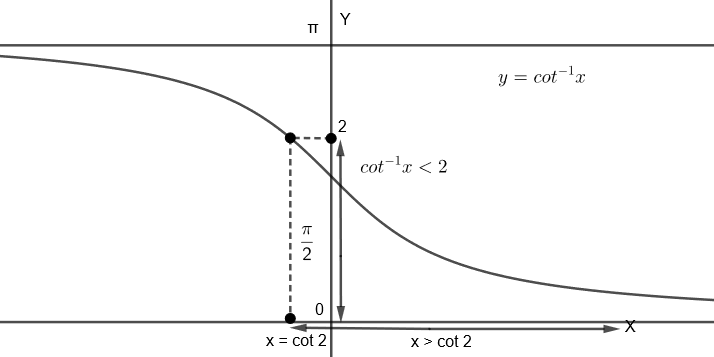Question
Question: All x satisfy the inequality \[{{\left( {{\cot }^{-1}}x \right)}^{2}}-7\left( {{\cot }^{-1}}x \ri...
All x satisfy the inequality
(cot−1x)2−7(cot−1x)+10>0, lie in the interval
(a) (−∞,cot5)∪(cot4,cot2)
(b) (cot5,cot4)
(c) (cot2,∞)
(d) (−∞,cot2)∪(cot5,∞)
Solution
Hint: First of all, let cot−1x=y and resolve the equation into factors and find the range of y=cot−1x. Then draw the graph of cot−1x to examine the values of x. Consider the domain and range of cot−1x properly for the correct values of x.
Complete step-by-step answer:
We are given that (cot−1x)2−7(cot−1x)+10>0.
Here, we have to find the values of x which satisfies this inequality.
Let us consider the inequality given in the question.
(cot−1x)2−7(cot−1x)+10>0
Let us consider cot−1x to be y. By substituting cot−1x=y in the above inequality, we get,
y2−7y+10>0
Here, we can write 7y = 5y + 2y. So, we get,
y2−5y−2y+10>0
We can write the above inequality as,
y(y−5)−2(y−5)>0
By taking out (y – 5) common, we get,
(y−5)(y−2)>0

If y > 5, then (y – 5) > 0 and (y – 2) > 0.
So, we get (y – 5) (y – 2) > 0
Hence, y > 5 satisfies the inequality.
For example, let us take y = 7. By substituting y = 7, we get,
(7−5)(7−2)=(2)(5)=10>0
So, we get, y∈(5,∞).
If 2 < y < 5, then (y – 5) < 0 and (y – 2) > 0
So, we get (y – 5) (y – 2) < 0
Hence, 2 < y < 5 does not satisfy the inequality.
For example, let us take y = 3. By substituting y = 3, we get,
(3−5)(3−2)=(−2)(1)=−2<0
So, we get, y∈/(2,5).
If y < 2, then (y – 5) < 0 and (y – 2) < 0.
So, we get, (y – 5) (y – 2) > 0
Hence y < 2 satisfies the inequality.
For example, let us take y = 0. By substituting y = 0, we get,
(0−5)(0−2)=(−5)(−2)=10>0
So, we get y∈(−∞,2).
Hence, we get y∈(−∞,2)∪(5,∞).
We had assumed that cot−1x=y, so by substituting y=cot−1x, we get,
cot−1x∈(−∞,2)∪(5,∞)
So, we get cot−1x<2 and cot−1x>5.
Now, we will see the graph of cot−1x, that is

We know that the range of cot−1x is (0,π), so it can’t be greater than 5.
Now, considering cot−1x<2
From the graph, we can see that, for cot−1x<2, x>cot2
So, we get x∈(cot2,∞).
Hence, the correct answer is option (c).
Note: After getting cot−1x∈(−∞,2)∪(5,∞), students often make this mistake of calculating x as x∈(−∞,cot2)∪(cot5,∞) but this is wrong as we know that cot−1x could not be greater than 5 because its range is (0,π). Also for cot−1x∈(−∞,2), x∈(cot2,∞) not (−∞,cot2). So for inverse trigonometric function, it is advisable to first draw the graph and then only examine the values of x for the correct results.
